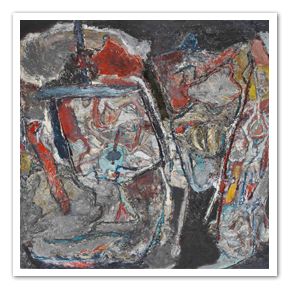Abstraction

During the Second World War, abstract art became less popular, although without being completely forgotten. Surrealism however remained boyant.
Later, a number of artists turned away from surrealism, and gradually moved towards lyrical abstraction, in which dreams and the subconscious were evoked.
It was the CoBrA artists who were the link between the first generation of abstract art in the 1930s, which had sunk into oblivion, and the Jeune Peinture Belge. The debate between figurative and abstract art began to rage while other principles of creation were being established.
Matter seemed to play a key role in creating a work: stones, sand, magmas of paint as well as colours were all important elements. The pre-eminence of action and speed of execution left the result obtained to chance. These were the principles that guided the artists in their work.
Then came two other trends, each developing alone. On the one hand, there was lyrical abstraction, as practised by artists such as Dotremont, Alechinsky, Jorn, Van Lint and Corneille. Their abstract art placed the accent on the interpretive transposition of reality. The works that resulted from this process are formless compostitions in which brushstroke and line predominate together with matter and colour.
Developing this movement still further, gestural painting made its appearance, removing form in favour of the brushstroke. This latter style was followed by artists such as Van Velde, Tal Coat and Soulages.
In parallel with lyrical abstraction, the second trend in development was geometric abstraction. Jo Delahaut was the theoretician, claiming the sense of construction and ending with geometric abstraction that rejected the object in favour of layouts with plans. The requirement of this pictural technique is clarity of form.
